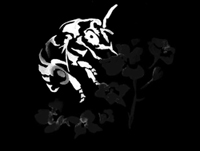Agamospermy
A form of asexual reproduction where a seed is formed without fertilization occurring. The seed contains only the genetic information from the single parent plant
Anemophily
A type of pollination in which pollen is distributed by the wind; examples of anemophilous plants include most grass species: wheat, rice, rye, barley, oats, etc.
Anther
The component of the male floral reproductive structures in which pollen grains are produced
Autogamous
A term for flowers whose ovules are reproductively compatible with pollen from the same flower, from the same plant, or from another plant individual
Biotype
A group of individuals sharing certain biological characters that distinguish them from other individuals of that species
Buzz pollination
Pollination by a flower-visitor who physically agitates the flower parts to release pollen; bumblebees are an example of insect pollinators that perform buzz pollination
Cleistogamy
A form of self-pollination in which flowers remain unopened and are fertilized inside by their own pollen
Composite flower
A conglomerate of tiny flowers (florets) that organize together to form a singular structure; examples include the flower heads of daisies and sunflowers
Cross-Pollination
Transfer of pollen from one plant to the stigma of a different plant in the same species
Dioecious
From the Greek root meaning “two houses”; refers to a plant in which male and female reproductive functions are found on separate individuals who possess only imperfect flowers of one gender
Domicile
An abode or residence; examples of domiciles for wild or alternatively managed pollinators include drilled wood blocks and cardboard tube nests.
Endosperm
Tissue within the seed that develops along with the embryo, and which serves as a nutrient source during germination
Entomophily
A type of pollination in which pollen is transported by insects; occurs in a large number of flowering plants, including many tree fruit
Floret
A small or reduced flower
Frame
A moveable, structural component of standard honey bee hives on which bees build their wax combs
Geitonogamous
A term for flowers whose ovules are reproductively compatible with pollen from a flower of the same plant or from another plant individual, but are not compatible with pollen from within the same flower
Germplasm
Any plant tissue containing genetic information which can be used to develop new individuals; seeds and vegetative tissue such as leaves are both examples of germplasm
Herkogamy
The physical separation of male and female reproductive structures within a single flower, which reduces interference between the functioning parts.
Hybrid
The offspring resulting from sexual reproduction between two genetically and/or physically unique individuals; hybrids often will possess positive traits from each parent
Imperfect flowers
Flowers which contain reproductive organs of only one gender, male or female
Inbreeding
Fertilization between two genetically identical (self-fertilization) or similar individuals; can result in the expression of harmful mutations in resulting offspring
Inflorescence
The section of a plant body that is modified for reproduction, including flowers, stalks, stems and modified leaves
Keel
In legume flowers, two petals that form a cover over the reproductive structures in a keel-like shape
Monoecious
From the Greek root meaning “one house”; refers to a plant in which male and female reproductive functions are present in the same individual. Male and female structures may be distributed on the plant in either perfect flowers, imperfect flowers, or a combination of both.
Mutualism
An interaction occurring between organisms in which each participant experiences a benefit
Nectar
A sugar-rich liquid which contains other molecules such as amino acids, minerals, etc.; serves as an attractant to pollinating animals and is an important energy source for them
Nectaries
Nectar-producing glands located within flowers (floral) or along leaves (extrafloral)
Ovule
The component of the female reproductive structures which develops into a seed following fertilization with male pollen; analogous to an egg in animals
Parthenocarpy
A developmental phenomenon where a fruit develops without fertilization or without mature seeds forming, resulting in seedless fruit
Perfect flowers
Flowers which contain both male and female reproductive organs; hermaphrodite flowers
Pheromone
A chemical released by an organism that influences other individuals of the same species
Pistil
The collective term for the female floral reproductive structures (style, stigma and ovary)
Pistillate flowers
Unisexual flowers that possess only female reproductive structures, pistils; antonym of staminate flowers, which possess only male stamens
Pollen
Small, motile male reproductive structures which fuse with the female ovules to produce a genetically new offspring; analogous to sperm in animals
Pollen limitation
When inadequate pollen availability results in plants producing fewer fruits and/or seeds than they have the capacity for
Pollen tube
The outgrowth of a germinated pollen grain which grows down into the female ovule to effect fertilization
Pollenizer
A plant which provides pollen; in self-incompatible species such as apples, pollen from a different variety is needed for cross-pollination and fruit production
Poricidal anthers
Anthers which shed their pollen through pore-like openings; often require physical agitation to loosen and release pollen
Self-fertile/Self-compatible
A plant than can produce viable offspring through self-fertilization; the opposite condition of self-incompatible plants which must be cross-pollinated to produce seed
Self-pollination
Transfer of pollen to a stigma within the same flower or between flowers on the same plant individual
Stamen
The collective term for the male floral reproductive structures (filament and anther)
Stigma
The component of the female reproductive structures on which pollen grains must be delivered in order to germinate and fertilize the ovule
Style
Stalk-like component of the female floral reproductive structures, between the stigma and the ovary
Tripping
In flowers like those of alfalfa, the activity of a pollinator that causes the pistil and stamens to be released from tension beneath the keel petals and exposed
Xenogamous
Flowers whose ovules are compatible only with pollen from genetically different plant individuals of the same species.
